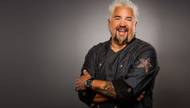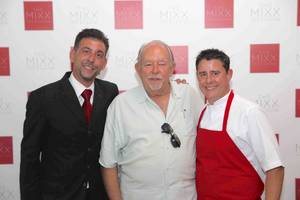He’s the king of New Orleans, a Vegas pioneer and, of course, the culinary superstar who—Bam!—started a food-television revolution. But what I love most about Emeril Lagasse is that he knows he’s still learning what it means to be a chef. He’s a man who remains deeply moved by great food and where it comes from and where it takes you and how it makes you feel.
In his new six-episode Amazon TV series, Eat the World with Emeril Lagasse, which will be available for Prime members September 2, Emeril and fellow Vegas celebrity chef José Andrés visit modernist-cuisine godfather Ferran Adrià in Spain. Adrià, whose El Bulli was widely considered the world’s most inventive restaurant before it closed in 2011, now runs a think tank. He’s got a team of biologists, historians and sociologists at his El Bulli Lab working on Bullipedia, a future-minded repository of cooking knowledge.
Adrià is Andrés’ mentor, and this is the first time cameras have been allowed into the El Bulli Lab. As the two Spanish chefs and their American friend talk about the essence of a tomato and how cooking is about technique and science but how passion drives creativity more than anything else, Emeril gets emotional. “I feel like I need to start from scratch,” he says, choked up, as he hugs Adrià.
Earlier in the episode, Emeril and Andrés visit chefs Pedro and Marcos Morán’s Casa Gerardo. It’s there that Emeril realizes that despite all the countless meals of red beans and rice he’s made, there’s a lot he hasn’t considered about how to prepare and eat a bean. (Also, if you’re into baby eels getting boiled alive in consomme, visit Casa Gerardo.)
Along with being a reminder that Vegas is blessed with so many of the best chefs on earth, Eat the World is a show where humble host Emeril is in awe of what’s he’s experiencing. It’s great TV, because what’s new and wondrous to the viewer was just as new and wondrous to Emeril when he encountered it.
“It’s really awesome,” Emeril tells me. “As much TV as I’ve done over the years, this was really, really special. My philosophy for many years is if you can understand the people and you can understand the culture, then you will understand the food.”
The first episode features yet another Vegas star chef, Mario Batali. It begins at Batali’s Babbo in New York. “He made his grandmother’s ravioli with calf brains,” Emeril says. “It sounds disgusting, but it was absolutely delicious. It was an incredible way to start the whole thing.”
Instead of heading to Italy, they book it to Shanghai to eat their weight in soup dumplings. “The whole time, we’re comparing the soup dumpling to a ravioli, the thickness, the filling and the broth,” Emeril says.
Emeril does visit Italy with Nancy Silverton, the LA chef who partnered with Batali on Mozza. They devour Franco Pepe’s pizza, which Silverton considers the best pizza in the world.
Silverton and Emeril, of course, came up in a different time, when being a chef wasn’t about celebrity or tattoos or fly-by-night pop-ups or loud casual restaurants or buzzwords like “hyper-local” or “farm-to-table.” You just got your hands covered in dough before the sun rose and sourced the best ingredients, because of your own exacting standards.
“I was with a bunch of chefs yesterday, and we got into this discussion about how it’s not like it used to be,” Emeril says. “We were at a restaurant, and there was not one chef coat there; they were all frocks.”
Having run restaurants in Vegas for more than two decades, Emeril has learned to offer something for everyone, whether they’re looking for elegant dining or sports-bar food. “The American diner, their palates have changed. They don’t necessarily want fussy, snooty stuff.”
But of course, there’s still no other city in the world that does high-end food and wine the way Vegas does.
“Las Vegas has become a dining mecca,” Emeril says. “I was talking to some people who were on a recent trip. I asked them, ‘Did you go to gamble?’ They said, ‘No, we went to eat.’ When did you hear that 20 years ago? You could barely get out of a buffet without people saying, ‘Good luck.’ I’m so proud of the dining scene in Vegas now.”
Emeril remembers how Danny Wade and his MGM Grand team brought in Mark Miller’s Coyote Cafe, Wolfgang Puck and Charlie Trotter and changed the game. MGM, where Emeril’s New Orleans Fish House opened in 1995, “realized they knew how to do a rodeo, how to do a concert, they even did a fairly decent job managing 5,000 rooms,” Emeril recalls. “But they realized they were terrible restaurant operators.”
So they scoured the country for the best culinary talent and now have a dining collection that includes restaurants from Joël Robuchon, Michael Mina, Tom Colicchio and, soon, Masaharu Morimoto.
Emeril, whose Vegas empire also includes Delmonico Steakhouse at the Venetian and Table 10 and Lagasse’s Stadium at the Palazzo, also credits the Venetian’s Sheldon Adelson and Rob Goldstein for “going after great restaurants and restaurateurs.”
“They had a vision that they weren’t going to have a food court with McDonald’s, Burger King and Dunkin, Donuts,” Emeril says. Instead they’ve got guys like Emeril and Batali making burgers with Creole flavors, foie gras and heritage bacon.
Eat the World also includes visits to Sweden with Marcus Samuelsson, South Korea with Danny Bowien and Cuba with AarÓn Sánchez. The latter was especially inspiring for Emeril, because so much of Cuba’s food culture comes from necessity. He visited urban farms and chefs who built their own ovens but don’t have the basic kitchen tools you can find in any American department store.
“I gave one of the chefs a vegetable peeler, and the guy cried. They may have one knife. I’m going to fill my suitcase next time before I go back,” Emeril says. “I asked a lot of chefs, ‘If you could have something, what would it be?’ One guy said, ‘I would kill for a mixer.’”
That’s the thing about eating the world. One day you see the vanguard of molecular gastronomy and another you visit a place where the government controls the seafood supply. And you realize there’s so much you can learn in both situations and that sharing knowledge and food is one of the best ways to connect cultures. So Batali and Emeril created their own version of a soup dumpling and served it to the chefs of the last restaurant they visited in Shanghai.
And then it was time to go eat again, even when the cameras weren’t rolling.
“People ask, ‘What did you do when you had some downtime? Well, we were looking for food,” Emeril says. “We were in markets and restaurants and the streets. That’s what happens when you get chefs together.”




